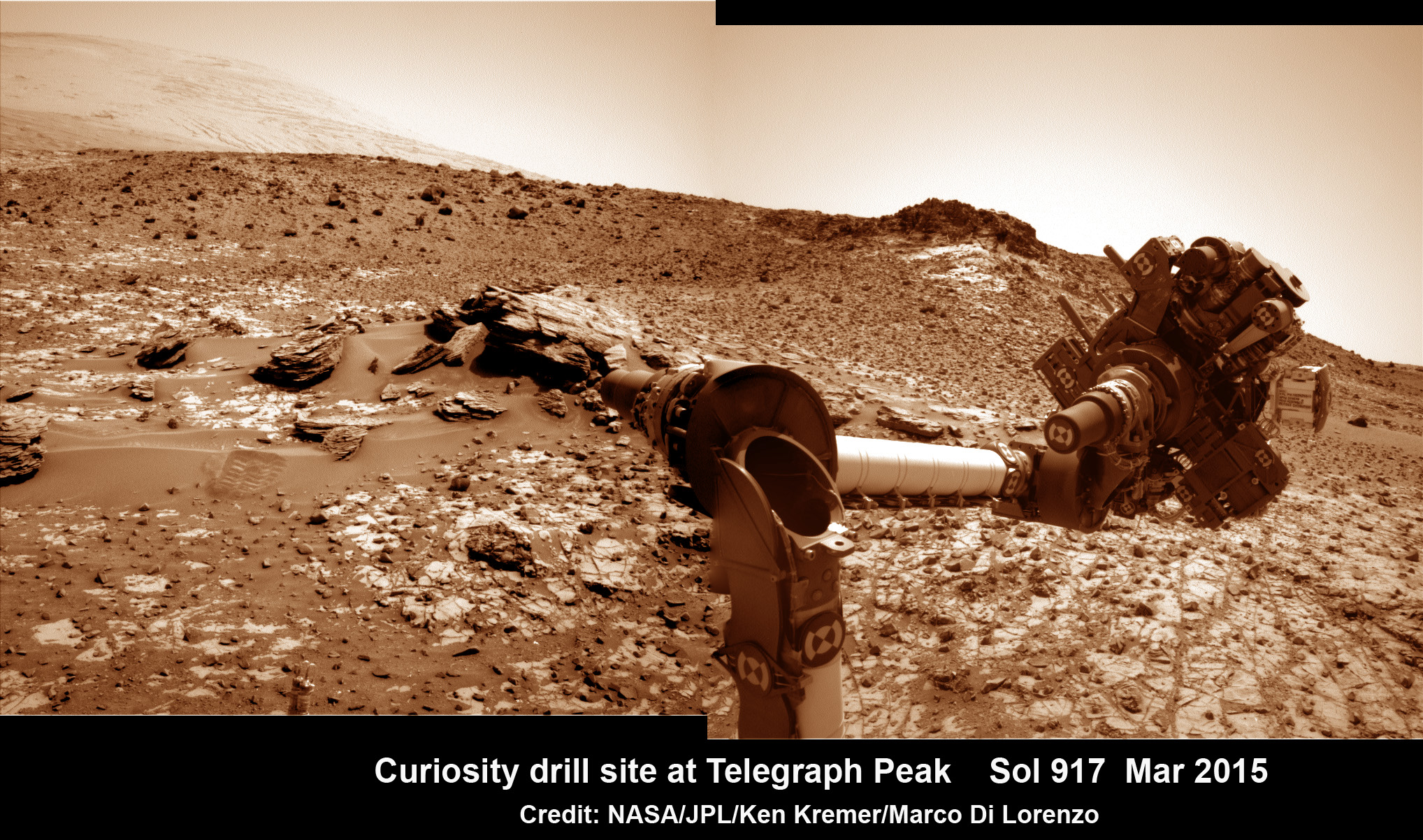
Engineers have determined that a transient short circuit recently detected in NASA’s Curiosity rover likely stems from the robot’s drill mechanism used to bore into Martian rocks and collect samples for detailed analysis by the on-board chemistry laboratories.
Movement of the one-ton Red Planet rover and its arm held high in a raised position has been halted as a precautionary measure, ever since the transient short circuit was detected late last month after Curiosity completed an otherwise successful drilling operation at a spot called “Telegraph Peak” at the base of Mount Sharp.
The team is hopeful they can resume rover arm operations and driving perhaps as soon as later this week, while continuing to carefully analyze the situation and cause no harm to the rover.
In the meantime, Curiosity has continued other science operations such as imaging and other observations from the mast-mounted cameras and atmospheric and weather monitoring. See our mosaic above of the raised drill.
Since rock boring and sample collection and analysis operations using the robotic arm and percussion drill are at the heart of and absolutely essential to the success of Curiosity’s ongoing mission to search for habitable environments on Mars, the scientists and engineers leading the endeavor must proceed cautiously.
As Curiosity drives up the mountain, it will examine new layers that scientists expect will record a transition from ancient wet environments on Mars that were more hospitable to life into newer and drier environments that are much less hospitable to life.
The hammering drill is located at the terminus of the 7-foot-long (2.1 meter-long) arm. The hole was drilled at Telegraph Peak on Feb. 24, 2015, or Sol 908.
A fluctuation in current on Feb. 27 triggered a fault-protection response that immediately halted action by the rover on Feb. 27, or Sol 911, NASA reported. The arm was raised and the robot was in the midst of actually transferring the new sample material from “Telegraph Peak” from the drill into another mechanism that sieves and portions the powder.
“The percussion action was in use, to shake the powder loose from the drill,” NASA indicated.
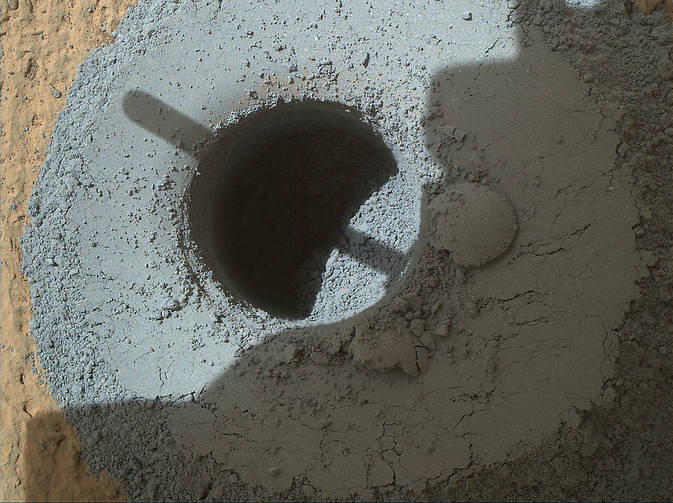
The team has kept the six-wheeled rover stationary since Sol 911 and has not moved the arm from the raised position since then, while they diagnosed the cause of the problem.
“We are running tests on the vehicle in its present configuration before we move the arm or drive,” said Curiosity Project Manager Jim Erickson, of NASA’s Jet Propulsion Laboratory in Pasadena, Calif., in a statement.
“This gives us the best opportunity to determine where the short is.”
Since then, the apparent short circuit was traced to the percussion mechanism in the drill itself.
“Diagnostic testing this week has been productive in narrowing the possible sources of the transient short circuit,” said Curiosity Project Manager Jim Erickson of NASA’s Jet Propulsion Laboratory, Pasadena, Calif.
“The most likely cause is an intermittent short in the percussion mechanism of the drill. After further analysis to confirm that diagnosis, we will be analyzing how to adjust for that in future drilling.”
To trace the source of the problem the team commended Curiosity to conduct a series of hammering action tests.
“During the third out of 180 up-and-down repeats of the action, an apparent short circuit occurred for less than one one-hundredth of a second. Though small and fleeting, it would have been enough to trigger the fault protection that was active on Sol 911 under the parameters that were in place then,” NASA officials stated.
If the results of the ongoing testing are satisfactory, Curiosity will complete the sample delivery to the chemistry labs and resume driving up from the base of Mount Sharp.
Curiosity is working in the “Pahrump Hills” outcrop area, where she arrived in September 2014.
“Telegraph Peak” was the third and last planned rock sample drilled at the “Pahrump Hills” outcrop, following the “Confidence Hills” and “Mojave 2” drill campaigns in September 2014 and January 2015.
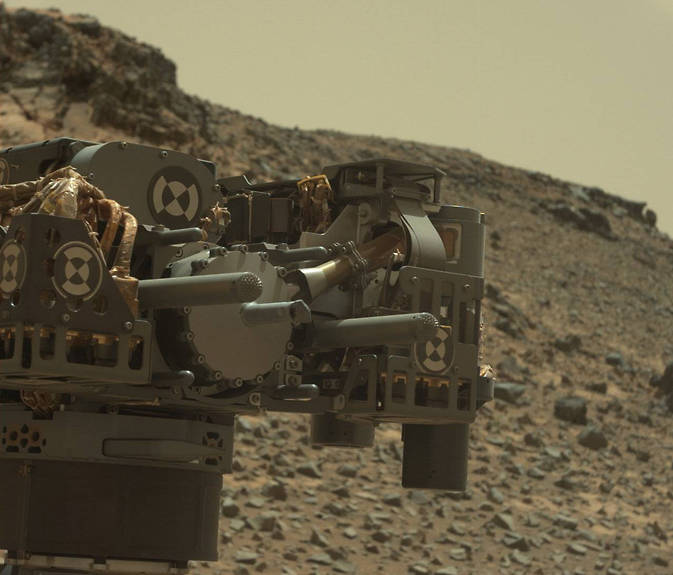
The drill sample at Mojave 2 was found to contain a more acidic content compared to Confidence Hills.
The team decided to drill at Telegraph Peak based on many measurements gathered by the rover, especially those from the Alpha Particle X-ray Spectrometer (APXS) on the rover’s arm.
Overall, the rocks samples at the Pahrump Hills have been found to be enriched in silicon compared to the elements aluminum and magnesium. The Telegraph Peak site is even more enriched in silicon and sits higher in the Pahrump Hills outcrop.
“When you graph the ratios of silica to magnesium and silica to aluminum, ‘Telegraph Peak’ is toward the end of the range we’ve seen,” said Curiosity co-investigator Doug Ming, of NASA Johnson Space Center, Houston.
“It’s what you would expect if there has been some acidic leaching. We want to see what minerals are present where we found this chemistry.”
Curiosity has successfully drilled six rock samples, and all five of the sample transfers to the CheMin and SAM lab units in the rover’s belly prior to Telegraph Peak were also all successful and yielded critical data for assessing the past and present habitability of the Red Planet.
While investigating the Mojave outcrop, the car-sized rover also has snapped her most recent selfie, a sweeping super wide-angle vista encompassing the spectacular alien terrain where she has been wandering, exploring, and working to unravel the mysteries of the Red Planet’s past and assess ancient habitable environments.
Prior to Mojave, Curiosity also snapped selfies at the “Rocknest,” “John Klein,” and “Windjana” sample-collection sites.
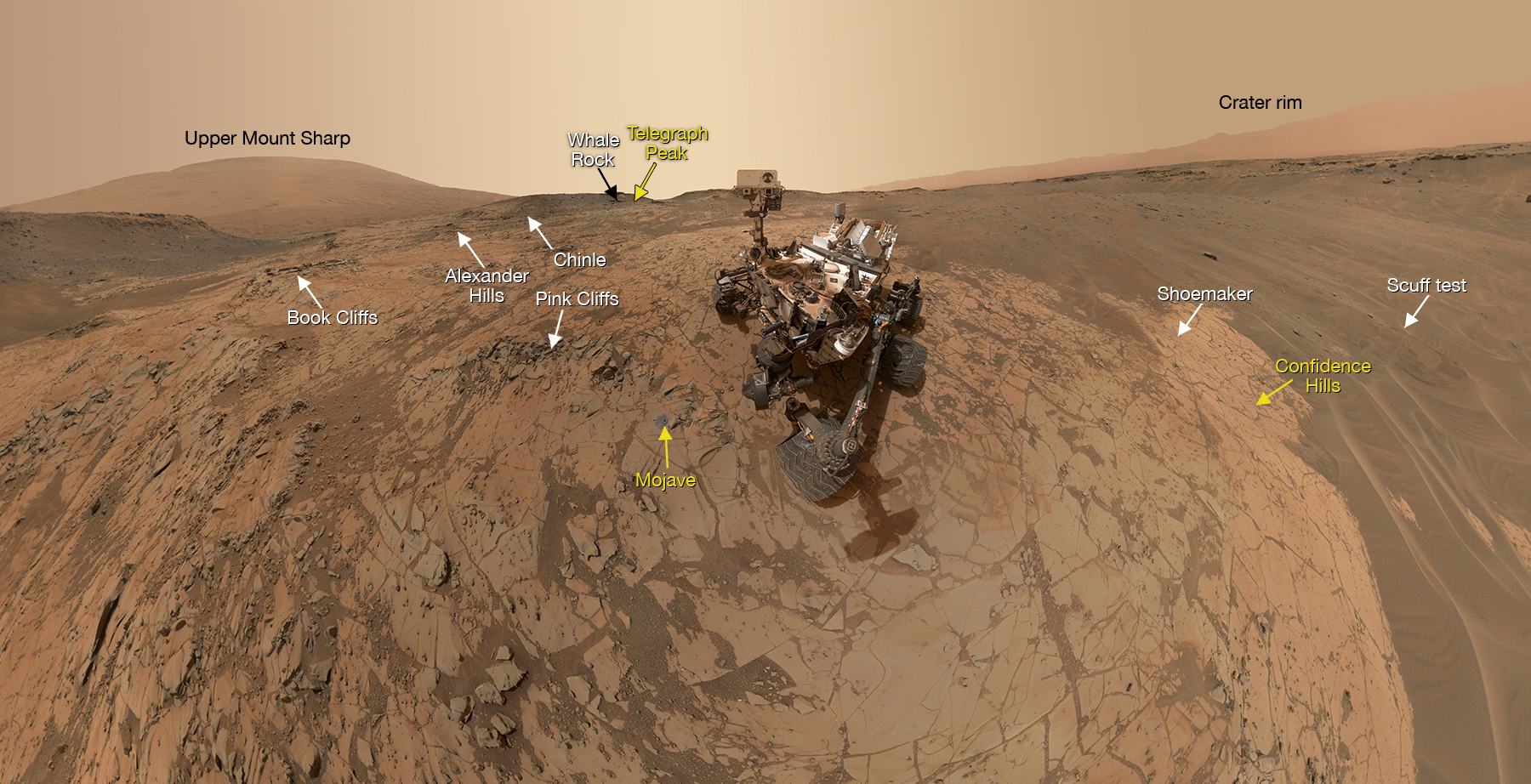
Image Credit: NASA/JPL-Caltech/MSSS
The “Pahrump Hills” outcrop belongs to the bedrock exposure of the Murray formation that forms the basal geological layer at the base of Mount Sharp, at the center of Mars’ Gale Crater.
Mount Sharp is comprised of sedimentary rock layers that record the history of ancient Martian environments and is the primary destination of the mission.
The mountain towers 3.4 miles (5.5 kilometers) into the Martian sky and dominates the center of the Gale Crater, where Curiosity safely touched down in August 2012.
So far, Curiosity’s odometer totals over 6.4 miles (10.3 kilometers) since landing inside Gale Crater on Mars in August 2012. She has taken some 221,000 images during over 920 Sols of exploration.
Meanwhile, older sister rover Opportunity just climbed to the summit of Cape Tribulation along Endeavour crater on the opposite side of Mars as celebrated her astonishing 11th anniversary roving the Red Planet!
Read the new AmericaSpace article about assembly operations for NASA’s next Mars mission named InSight here. InSight is set to launch March 4, 2016.
Stay tuned here for continuing updates from Mars and throughout our Solar System!
Want to keep up-to-date with all things space? Be sure to “Like” AmericaSpace on Facebook and follow us on Twitter: @AmericaSpace
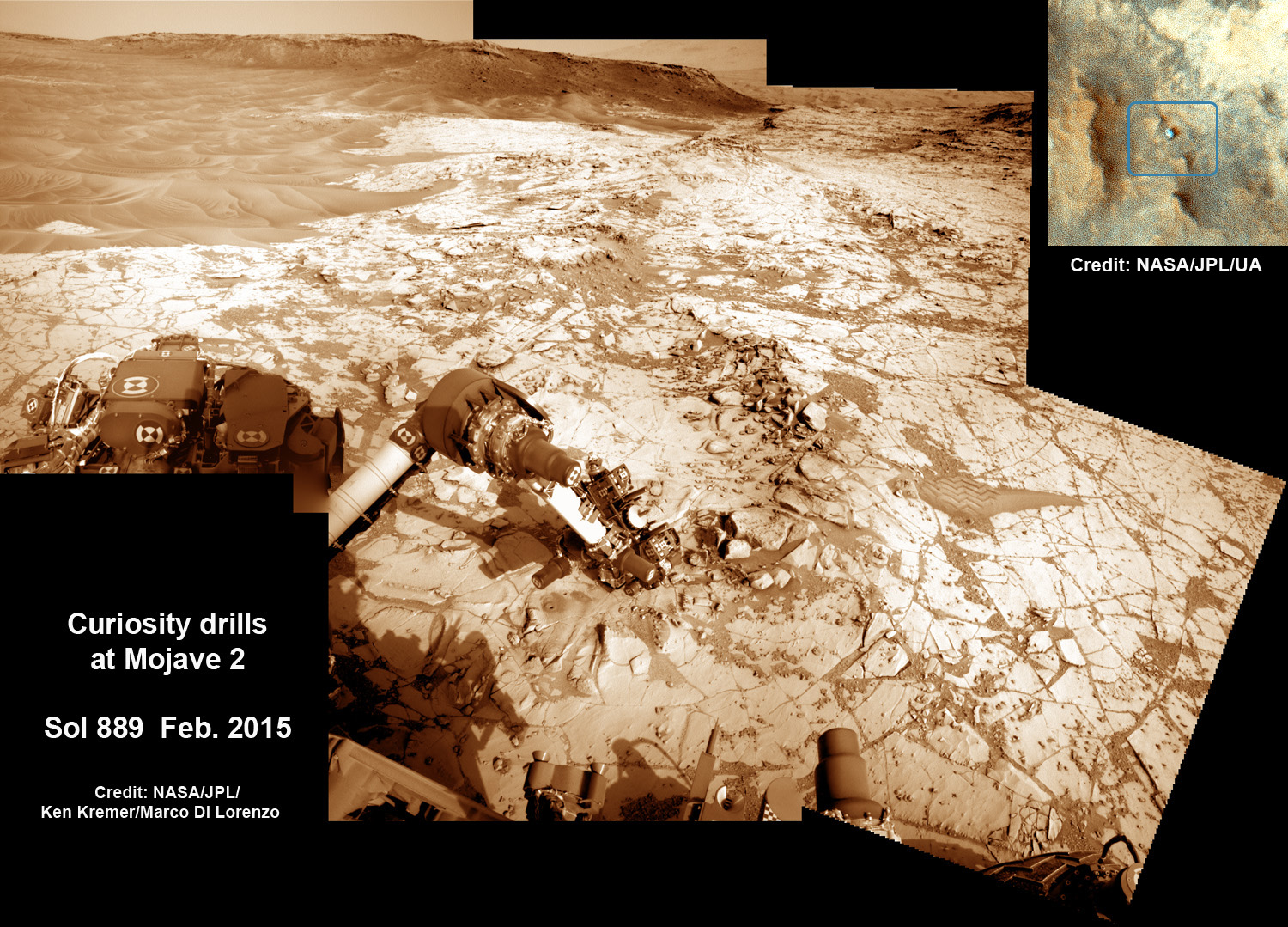
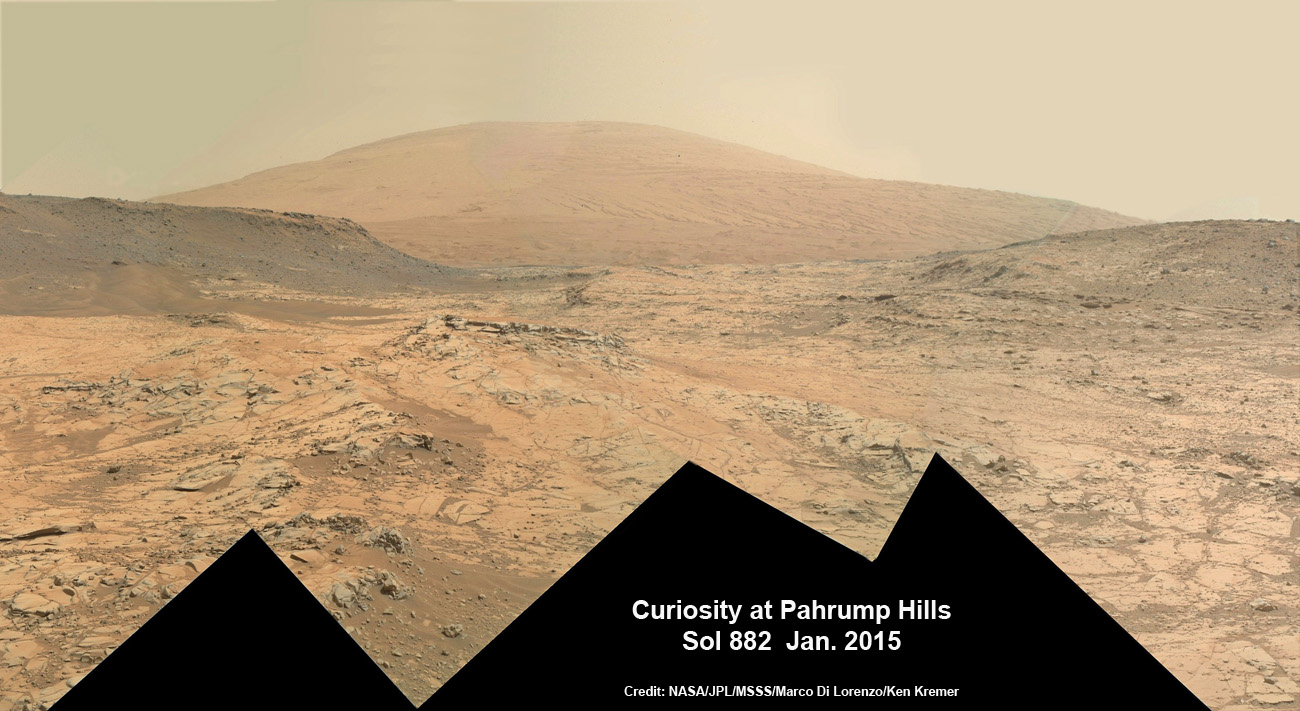




2 Comments
2 Pings & Trackbacks
Pingback:Curiosity Passes 10K Mark Roving to Next Science Destination at ‘Logan’s Run’ « AmericaSpace
Pingback:Curiosity Sees Blue Sunset on Red Planet « AmericaSpace